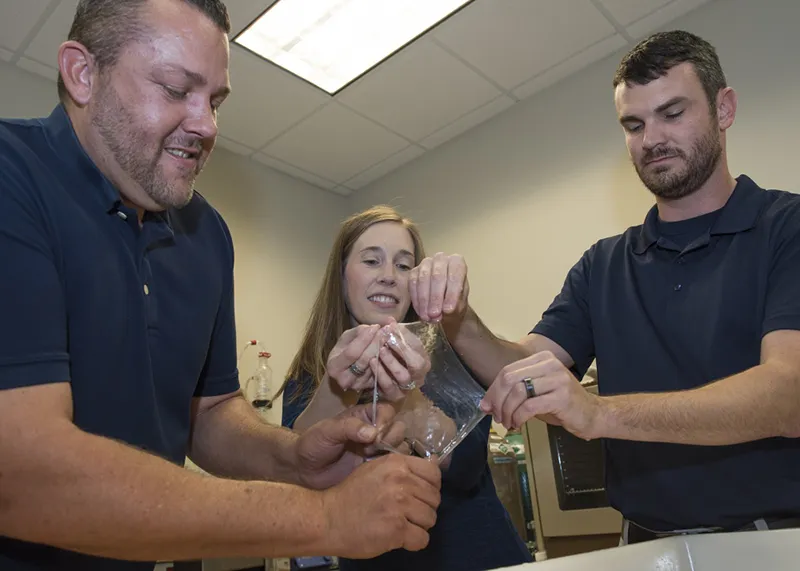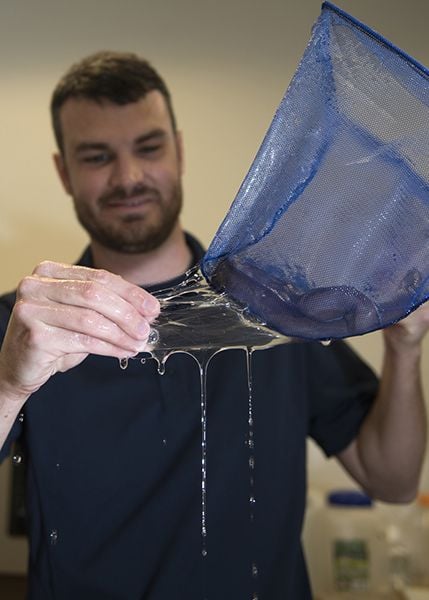If We Can Get Past the Ickiness, Hagfish Slime May Actually Be Useful to Us
The gelatinous glop could be the key to everything from bio-inspired kevlar to shark defense for divers
/https://tf-cmsv2-smithsonianmag-media.s3.amazonaws.com/filer/9a/7d/9a7dd604-5ddf-43da-a577-3f772cbeae61/hagfish.jpg)
Hagfish are far from cuddly. The pinkish eel-like creatures sport rows of toothy spikes around their mouth, allowing them to burrow into decaying animals like worms in dirt. But these oddballs are amazingly successful, able to inhabit a range of environments and have done so relatively unchanged for more than 300 million years. One of the keys to their success is an ingenious defense mechanism: slime.
When attacked by predators, these wriggly critters activate their slime glands, clogging their enemies’ gills with gelatinous glop—a gooey pepper spray of sorts that lets them escape unscathed. Few marine creatures are equipped to challenge this slimy defense system. Now, the U.S. Navy hopes to tap into the power of the slime, synthesizing an artificial version to keep their divers safe in the deep.
If you can get over the “ick” factor of the hagfish slime, the marine gelatin has many desirable properties. The goo is made of microscopic filaments, and though the skinny threads are thinner than a blood cell is wide, they are surprisingly strong. They’re also extremely long, extending nearly six inches. But the property that has intrigued many researchers—and caught the eye of Navy scientists—is the slime’s capacity for expansion. Once the slime mixes with water, it can grow to nearly 10,000 times its initial volume, according to Ryan Kincer, a materials engineer with the Naval Surface Warfare Center in Panama City.

The Navy researchers claim to have isolated the genes that code for the expansive filaments that make up the slime, which are actually made up of two separate proteins, explains Josh Kogot, a research biochemist working on the project. They inserted these genes into two batches of E. coli bacteria, allowing the microbes to do the work of producing the proteins. They then figured out a way to combine these proteins to create the slime filaments. The scientists were able to confirm that the faux slime threads were, in fact, similar to the real deal by closely examining them under a scanning electron microscope.
It is important to note, however, the Navy has not published any of their results. And they could only disclose a limited number of details about their research due to “potential intellectual property and possible technology licensing agreement with an industrial partner,” Katherine R. Mapp, a public affairs officer with the Naval Surface Warfare Center, wrote in an email. They believe, however, that if they can produce a slime-mimic in water, it could be used as a protective shield for navy divers.
The idea would be to use the slime like the hagfish do, deploying it in the face of approaching predators. The key, says Kincer, would be to keep the components of the slime contained, away from the water, until the diver needs to deploy it. Perhaps it could be carried in a pepper-spray type bottle, or perhaps it could somehow be incorporated into the diving suit. But the team sees many other possibilities for the slime, such as a bio-alternative to Kevlar, says Kogot.

So how does the slime actually form? Scientists are still working out the details. But they’ve discovered that the slime is made from a combination of two main components, the duo of protein filaments (what the Navy is aiming to mimic) and mucous (the gelatinous substance that gives snot and saliva its slippery texture). In the hagfish, the filaments are contained in thin cell membranes wound up “like a ball of wool,” says Lukas Böni, a researcher at ETH Zurich studying the slime for its potential applications in the food industry as an alternative to commercial gelatins that doesn’t require heating. The tiny fibrous bundles reside alongside packets of mucus in the some 150 slime pores that trail down both sides of the hagfish’s body.
When the hagfish feels threatened, it contracts these pores, releasing the balls of slime fiber and mucus bubbles. When they hit the water, the membranes burst and the tightly wound filaments expand.
“And that’s where our understanding ends,” says Douglas Fudge, researcher at Chapman University in California, who uncovered the surprising properties of the biofibers while doing research for his PhD. Somehow the fibers intertwine with the mucus forming a slimy underwater network that is mostly made up of water. The fibers seem to “form a spiderweb underwater,” says Böni, who is not involved in the Navy’s work.

Fudge, who is also not involved in the Navy’s work, and his team, are still untangling how the expansion actually happens. Figuring out this final mixing process would be a big hurdle to actually using the slime as defense. Another potential issue would be preservation. Böni and his team stabilize the hagfish ooze before it mixes with water using oil or a citrate buffer, but even then the components are only good for days or perhaps weeks.
The Navy researchers are far from the first to tap into the properties of this unusual substance. In 2015, a group in Singapore synthesized the protein filaments using what appears to be a similar method, inserting the genes for the protein into E. coli bacteria. Fudge’s research group is also interested in mimicking the slime, but rather than just creating the filaments, he wants to recreate the goo in its entirety to better understand how it forms.
“We’re really focused on this question of deployment—how it goes from concentrated stuff in the glands to its expansion in seawater,” Fudge says.
Though there are still many hurdles to synthetically producing the slime in large quantities, many see this viscous substance as the eco-material of the future, with potential applications in clothing, shark repellents and food.
So control that gag reflex.
“I ate it once,” Böni says. “It tastes like seawater.”
/https://tf-cmsv2-smithsonianmag-media.s3.amazonaws.com/accounts/headshot/Wei-Haas_Maya_Headshot-v2.png)
/https://tf-cmsv2-smithsonianmag-media.s3.amazonaws.com/accounts/headshot/Wei-Haas_Maya_Headshot-v2.png)